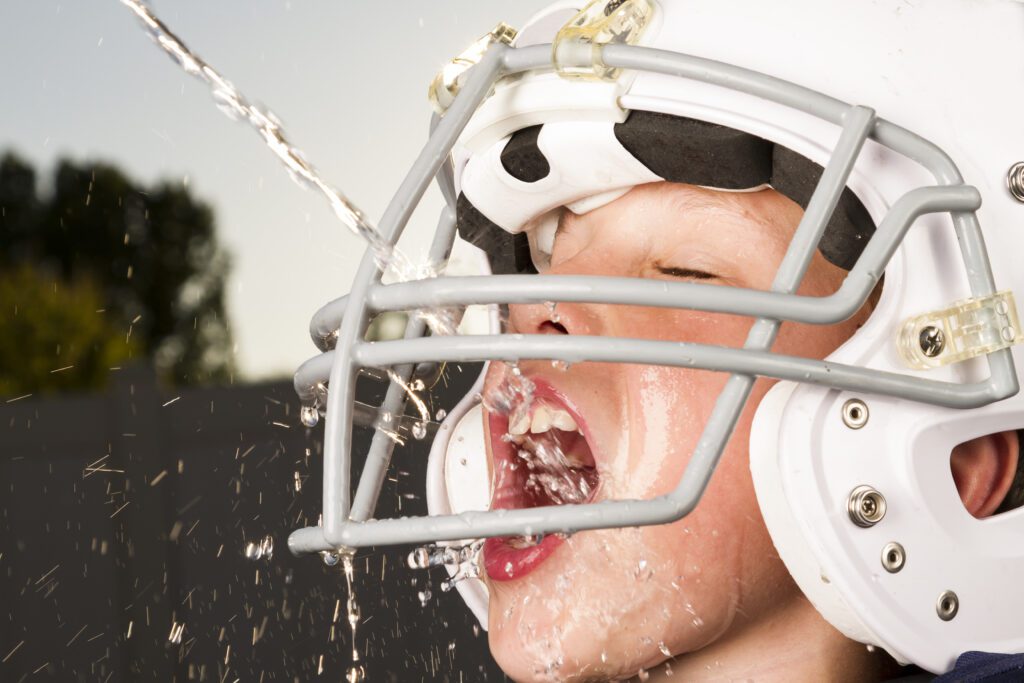School Guidelines, Practices Keep Student-Athletes Safe
by TERESA SCHIFFER
The temperatures in Central Florida can soar uncomfortably high, as any native can attest. For kids who have grown up here, it may be tempting to take that heat in stride. Unfortunately, high heat can have potentially life-threatening effects. As school athletics ramp up and the kids resume practices under the sun, it’s more important than ever to know how to keep them safe and hydrated.
According to the National Federation of State High School Associations, exertional heat stroke is the leading cause of preventable death in high school athletes, occurring primarily during summer months. During intense exercise, heat production increases in the body by as much as 15 percent to 20 percent, which can result in the body’s core temperature rising one to two degrees Fahrenheit every five minutes until the heat is dissipated.
Dr. Salvador Montenegro, a Sports Medicine specialist with Watson Clinic in Lakeland, says that while there are multiple existing guidelines depending on the various sports, one of the most fundamental priorities should be hydration.
“In general, start fluid intake 24 hours before an exercise event,” Montenegro says. “Fluid replacement is a vital component and must be addressed in a diligent manner.”
He recommends athletes drink 16 to 20 ounces of fluid within two hours of starting an activity, another 6 to 10 ounces 15 minutes before exercising, then 4 to 6 ounces every 10 to 15 minutes during activity. If it is possible to take weight measurements before and after the exercise, athletes can ensure they take in 16 to 20 ounces of fluid post-workout for every pound they drop during the activity.
Dan Talbot, Director of Athletics for Polk County Public Schools, explains how coaches and student-athletes strive to prevent dehydration on the field. State law requires that certain protocols be followed in order to protect these young athletes from heat illnesses.
The first thing that coaches and athletes do when gearing up for a new season of practices and games is a process of heat acclimatization, Talbot says. This involves gradually getting used to the temperatures by limiting the amount of activity time during the first practices outside, and gradually increasing that amount until reaching a defined limit. Football players, in particular, start their practices without their heavy protective gear on, adding pieces during subsequent practices until they are practicing fully suited up.
The heat acclimatization period lasts throughout the first 14 practices. During this time, student-athletes may not participate in more than six consecutive days of practice. Any student who enters into the training while the rest of the team is in the acclimatization period still must begin his or her process at the beginning and continue for the first 14 days of their participation. In addition, Talbot says student-athletes are discouraged from engaging in any other physical activities in the time between practice sessions.
Talbot explains that coaches and other personnel are the first line of defense in protecting student-athletes, and during games, local physicians volunteer to be present on the sidelines to help out if needed. They watch for students exhibiting any signs of heat illness, including such symptoms as fatigue, headaches, cramps, swelling of hands or feet, lightheadedness, or nausea. Since games take place at night, the risk of heat illness is significantly decreased, but daytime practices can be a different story.
Talbot describes what coaches are watching for when their students practice in the heat.
“It really starts with performance,” he says. “If a student-athlete is not really performing at a level they previously had, if there’s dizziness, a kid’s not feeling well, profuse sweating, those are usually the first signs.”
If an athlete is exhibiting signs of heat exhaustion, it is imperative that the student receive appropriate treatment immediately.
“Any athlete suspected of having severe heat illness requires immediate cooling,” Montenegro says. “The first hour is known as the ‘Golden Hour.’ Whole body immersion in cold water is key to treating severe heat illness. Fever-reducing medications should not be given. Mild symptoms are treated with fluid intake, rest in a cool area, massage, the stretching of cramping muscles, and elevation of swollen limbs. More severe cases should be transported to the hospital.”
Talbot confirms that Polk County schools follow this procedure, saying, “We have cold water tubs available, so if a student-athlete is showing signs of heat stress, we’re going to submerge him or her in that cold water immersion tub to cool them down. Once they’re submerged in the cold tub, we dump ice in there and then call 911 to transport them.”
Montenegro advises parents to keep a close eye on their young athletes and not to ignore any signs or symptoms of dehydration.
“Be prepared and always have a plan.”
